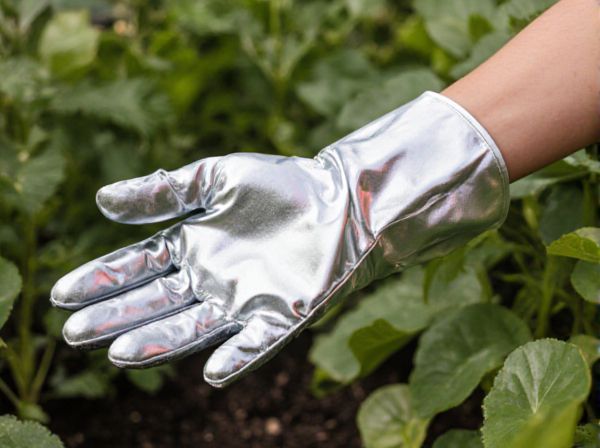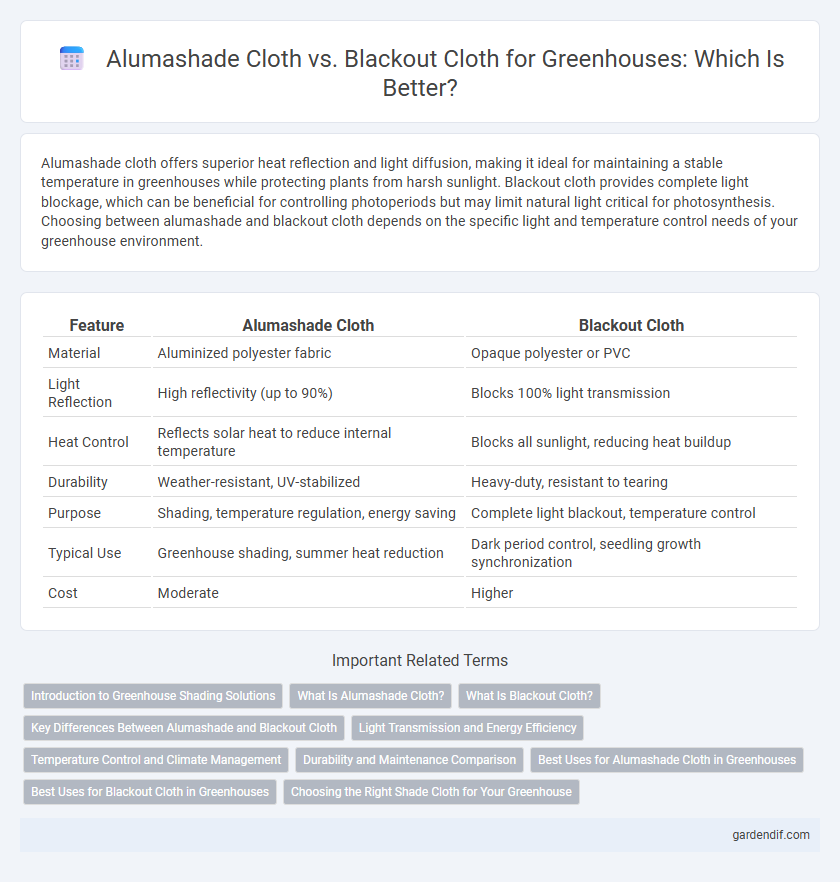
Alumashade Cloth vs Blackout Cloth Illustration
Alumashade cloth offers superior heat reflection and light diffusion, making it ideal for maintaining a stable temperature in greenhouses while protecting plants from harsh sunlight. Blackout cloth provides complete light blockage, which can be beneficial for controlling photoperiods but may limit natural light critical for photosynthesis. Choosing between alumashade and blackout cloth depends on the specific light and temperature control needs of your greenhouse environment.
Table of Comparison
| Feature | Alumashade Cloth | Blackout Cloth |
|---|---|---|
| Material | Aluminized polyester fabric | Opaque polyester or PVC |
| Light Reflection | High reflectivity (up to 90%) | Blocks 100% light transmission |
| Heat Control | Reflects solar heat to reduce internal temperature | Blocks all sunlight, reducing heat buildup |
| Durability | Weather-resistant, UV-stabilized | Heavy-duty, resistant to tearing |
| Purpose | Shading, temperature regulation, energy saving | Complete light blackout, temperature control |
| Typical Use | Greenhouse shading, summer heat reduction | Dark period control, seedling growth synchronization |
| Cost | Moderate | Higher |
Introduction to Greenhouse Shading Solutions
Greenhouse shading solutions play a crucial role in regulating light and temperature to optimize plant growth. Alumashade cloth reflects sunlight, reducing heat buildup while allowing diffused light to reach plants, whereas blackout cloth provides total light blockage to simulate darkness or protect sensitive crops. Selecting the appropriate shading material depends on the specific crop requirements and environmental conditions within the greenhouse.
What Is Alumashade Cloth?
Alumashade cloth is a reflective material used in greenhouses to regulate temperature and light by reflecting sunlight away, helping to prevent overheating. Made from woven fabric coated with aluminum or similar reflective substances, it enhances energy efficiency and promotes optimal plant growth by controlling light intensity. Unlike blackout cloth, which completely blocks light, alumashade cloth allows diffused light, balancing shading and illumination inside the greenhouse.
What Is Blackout Cloth?
Blackout cloth is a dense, opaque fabric designed to block nearly 100% of light from penetrating through, making it ideal for greenhouse applications requiring strict light control. Unlike Alumashade cloth, which reflects sunlight to reduce heat while allowing some light transmission, blackout cloth ensures complete darkness to support specific plant growth cycles or protect plants sensitive to light. Its high light-blocking capability also helps regulate temperature and prevent unwanted sunlight exposure in controlled environments.
Key Differences Between Alumashade and Blackout Cloth
Alumashade cloth features a reflective surface that efficiently reduces heat by reflecting sunlight, making it ideal for temperature control in greenhouses. Blackout cloth is made from dense, opaque fabric that completely blocks light, preventing photosynthesis and providing total darkness when needed. The key difference lies in their light management: Alumashade diminishes heat while allowing some diffuse light, whereas Blackout cloth eliminates light entirely for light-sensitive plant growth stages.
Light Transmission and Energy Efficiency
Alumashade cloth offers moderate light transmission, allowing some natural sunlight to pass through while reflecting excess heat, which enhances energy efficiency by reducing cooling costs in greenhouses. Blackout cloth provides near-total light blockage, creating a controlled environment ideal for managing plant growth cycles but may increase energy consumption due to supplemental lighting needs. Choosing between Alumashade and Blackout cloth depends on balancing light requirements with energy-saving goals specific to greenhouse operations.
Temperature Control and Climate Management
Alumashade cloth excels in reflecting sunlight, reducing heat buildup in greenhouses by up to 30%, which maintains a cooler internal temperature during peak sunlight hours. Blackout cloth completely blocks light, providing superior temperature control by preventing solar radiation from entering, ideal for climate-sensitive plants requiring darkness and cooler conditions. Both materials contribute to precise climate management, with Alumashade offering light diffusion and partial shading, while Blackout ensures total light exclusion for strict environmental control.
Durability and Maintenance Comparison
Alumashade cloth offers high durability with its reflective aluminum coating that resists UV rays, reducing wear and tear in greenhouse environments. Blackout cloth provides excellent light-blocking properties but typically requires more frequent maintenance due to susceptibility to mold and degradation from constant moisture exposure. Choosing alumashade cloth enhances longevity and minimizes upkeep, making it a practical option for durable greenhouse shading.
Best Uses for Alumashade Cloth in Greenhouses
Alumashade cloth is ideal for greenhouses requiring controlled light diffusion and moderate shading, promoting photosynthesis while preventing overheating. Its reflective properties reduce heat buildup, making it suitable for nurseries and seedling propagation where precise temperature regulation is critical. Unlike blackout cloth, which blocks nearly all light, alumashade ensures plants receive ample indirect sunlight, enhancing growth in temperate climates.
Best Uses for Blackout Cloth in Greenhouses
Blackout cloth in greenhouses is essential for controlling light exposure, effectively blocking all sunlight to create complete darkness for sensitive plants or nighttime cooling phases. It enhances energy efficiency by reducing heat buildup and preventing unwanted photosynthesis during critical growth cycles or dormancy periods. Ideal for propagating seedlings, managing photoperiod-sensitive crops, and regulating temperature, blackout cloth ensures optimal growing conditions and improved plant health.
Choosing the Right Shade Cloth for Your Greenhouse
Alumashade cloth offers reflective properties that reduce heat buildup while allowing sufficient light transmission, making it ideal for plants requiring moderate sunlight. Blackout cloth completely blocks light, providing maximum shade and temperature control, beneficial for seedlings and light-sensitive crops. Selecting the right shade cloth depends on your greenhouse's specific light and temperature needs to optimize plant growth and energy efficiency.
Alumashade Cloth vs Blackout Cloth Infographic

 gardendif.com
gardendif.com